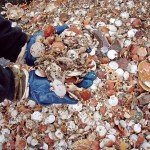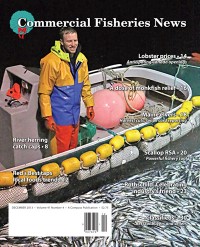GLOUCESTER, MA – Atlantic sea scallop fishermen are becoming increasingly concerned about the potential impact of global warming, ocean acidification, predation, and disease on their fishery.
Mike Marchetti, president of the Eastern New England Scallop Association, summed it up pretty succinctly this past winter during a meeting of the New England Fishery Management Council’s scallop advisory panel (AP) when he said he had learned a lesson from his 30 years in the lobster industry.
“I’ve seen what the effects of pesticides, oil spills, and other things did to the lobster fishery in Southern New England. In the back of my mind, it’s always a worry that something could come up from behind and bite us in the ass with scallops,” he said.

VIMS photo
Intensive scallop resource surveys always rank as “highest” priorities in the annual industry-funded research set-aside (RSA) program. This photo from a single tow in the Hudson Canyon Closed Area shows large numbers of two-year-old scallops, a sign of an abundant adult population in the years to come. The tow was part of the 2012 Mid-Atlantic survey by commercial scallop boats and researchers at the Virginia Institute of Marine Science (VIMS).
So, scallopers this year decided to use the most powerful tool they had at hand – the industry-funded scallop research set-aside (RSA) program – to focus more research on critically important environmental and product-quality issues. The submission deadline for the next round of RSA proposals is Dec. 2.
Fishermen in this forward-thinking fishery support having managers take 1.25 million pounds of scallops off the top of each year’s annual catch limit to devote to research. That’s a lot of scallops. And it translates into a lot of money – $10 million if scallops are running $8 per pound, $12.5 million if they’re running $10 per pound, and, well, if they’re $12 or higher … you do the math…
 Read the rest and much, much more in the December issue of Commercial Fisheries News. Read online immediately and download for future reference.
Read the rest and much, much more in the December issue of Commercial Fisheries News. Read online immediately and download for future reference.









 Updating...
Updating...